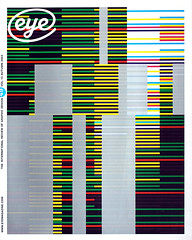Autumn 2003
How hip-hop changed the way things look
Yes Yes Y’all, An Oral History of Hip-Hop’s First Decade
By Jim Fricke and Charlie Ahearn<br>Introduction by Nelson George<br>The Perseus Press, £14.99<br>I have to admit I’m not the greatest fan of Hip-Hop so it’s a bit of a surprise that I find myself recommending Yes Yes Y’all as an important book for graphic designers, since it revisits the period of Hip-Hop’s birth in the Bronx in the late 1970s. My interest in the book is that it tangentially answers a crucial yet often neglected question for graphic designers: ‘Where does style come from?’ Visual styles are fully formed and identifiable when they present themselves via mainstream culture, but prior to this they’ve often grown organically, behind the scenes, from a subculture. Designers rarely get to see this gradual process since those who make the visuals often operate outside the traditional design community.
The book tracks the development of the subculture of New York Hip-Hop through anecdotes and recollections from its pioneers. Rather than attempting to create a definitive historical document, the text is comprised of oral recollections of Old School MCs, DJs and B-Boys. The transcriptions are personal, informal and often opinionated, the recollections reflect the personalities of the founders of Hip-Hop culture; some retain their humility while others opt for egomania.
Yes Yes Y’all is colourful and lively with plenty of period photographs and printed ephemera – predominantly in the form of event flyers. These early flyers are low-budget items, cobbled together with rubdown type and traced letters, flat compositions with cartoon or line illustrations. Graffiti artists from the period, such as Phase 2, often designed these cheaply printed handouts to advertise DJ battles; sometimes the performers themselves designed the flyers, such as Grandmaster Caz, who was also an accomplished graffiti artist. The obvious influences for the style of the lettering and illustrations are comic books and cartoons, a reference that extends to the names of many of the crews – the Furious 5, Fantastic 4, Klark Kent, as well as the graffiti artists – Futura, Blade, Comet and the Fab 5. The comic book as a source of visual inspiration comes as little surprise when you look at the photographs and realise just how young many of the participants in the early scene were. There are a number of flyers by Buddy Esquire and his brother Eddie Ed, which have a slightly more professional tone, despite their masses of irregular hand-drawn type and the vernacular hand-lettering, they seem more conscious of ‘professional’ design.
The flyers bear little resemblance to the mainstream codified Hip Hop visual tropes that emerged during the 1980s, instead they have a ‘do-it-yourself’ aesthetic closer to punk zines from the mid to late 1970s in the UK (many of the early protagonists of both subcultures notably share a background of economic and social hardship, as well as outsider status). I found it interesting to discover the odd lag between the styles of the flyers and the development of train graffiti. There was stylistically sophisticated train graffiti as early as 1973 (in the book, Pistol claims he invented ‘3-D graffiti’ in 1973), yet this developed lettering and illustration style is only clearly visible in the flyers from 1977 onwards, perhaps due to the scale and colour restrictions of the flyers.
One highlight in Yes Yes Y’all is the inclusion of a few pages from the sketchbooks of Phase 2 and Super Kool 223. Many of the early writers would congregate after school at what became known as ‘the Writers Bench’ at 149th St and Grand Concourse, to trade tips and critique the graffiti on passing trains. Henry Chalfont, producer of the recently re-issued documentary Style Wars, claims it was ‘like a mini art world going on right there’. As the flyers advance chronologically, the influence of graffiti and train-writing on Fab 5 Freddy, Phase 2, Zephyr and Lee is clearer. The letterforms are more decorative and intertwined, serifs grow into dysfunctional decoration, and multiple outlines appear around letters. The graphic style we now associate with Hip-Hop is apparent as a mature and marketable aesthetic. Hip-Hop stops growing as a subculture and becomes ‘Hip-Hop’.
Despite the fact that most of these early writers (and even the early rappers and DJs) failed to benefit monetarily when Hip-Hop became a multi-million dollar industry (shifting to mainstream culture) their energy, spirit, enthusiasm, and talent, can be a model for graphic designers. These are not ‘designers’ with ‘clients’; these are individuals who are an integral part of a subculture. They profoundly affected visual culture, producing a distinctive lettering style that travelled from the streets of their New York neighborhoods throughout the rest of the world. They stand as a reminder that a subculture is not a hobby, a subculture shapes every aspect of your life and that commitment and enthusiasm for making specific visual form is an inspirational model for graphic designers, even those who don’t like Hop-Hop.
Michael Worthington, designer, teacher, Los Angeles
First published in Eye no. 49 vol. 13 2003
Eye is the world’s most beautiful and collectable graphic design journal, published quarterly for professional designers, students and anyone interested in critical, informed writing about graphic design and visual culture. It is available from all good design bookshops and online at the Eye shop, where you can buy subscriptions and single issues.

